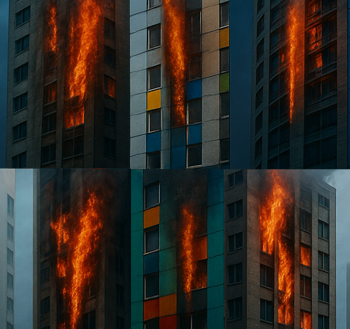Hydrogen embrittlement
Hydrogen embrittlement occurs as a result of exposure to hydrogen, for example, in the manufacture or processing of high-strength steels and titanium and aluminium alloys. It reduces the ductility and load-bearing capacity of affected materials, which can cause cracking or failure at below normal yield stresses.
Hydrogen embrittlement takes place when recently-produced, nascent hydrogen atoms diffuse into the metal. When load is applied, the hydrogen atoms migrate towards areas of high stress, and the resulting pressure causes sub-microscopic cracking. These cracks themselves become areas of high stress, and so the process continues and the cracks spread through the material, which can ultimately result in failure.
In November 2014, two large bolts fractured at the 47-storey, 737ft Leadenhall Building, popularly known as ‘The Cheesegrater’ because of its distinctive slanting profile, created to respect a protected sight line of St Paul’s Cathedral. A small part of one of the bolts fell from the fifth floor to the ground, but the area was not publicly accessible due to ongoing construction works and nobody was injured.
A third bolt then fractured but was captured by tethering which had been installed following the first two failures.
Investigations undertaken by contractor Laing O’Rourke and structural engineers Arup confirmed that the problem was limited to certain bolts. Tests concluded that the bolts had failed due to hydrogen embrittlement. Arup also confirmed that there was no adverse effect on the structural integrity of the building. However, a programme was undertaken to replace a number of bolts a precautionary measure.
In April 2019, Structural steelwork contractor Severfield released a trading update announcing that it had reached a final settlement with developer Leadenhall following “extensive negotiations”. Ref http://www.constructionmanagermagazine.com/news/severfield-settles-over-cheesegrater-bolts/
[edit] Related articles on Designing Buildings Wiki
- Brittle fracture.
- Corrosion.
- Degradation of construction materials.
- Failure of cast iron beams.
- Failure of metals.
- Graphitisation.
- Leadenhall building.
- Rust.
- Spalling.
[edit] External references
- Global Construction Review. Fear of failure: Why bolts on London’s Cheesegrater tower began to break. 16 January 2015.
Featured articles and news
Grenfell debarment investigations paused
By request of CPS to safeguard integrity of criminal proceedings. The community reacts.
Delivering for tenants; National Retrofit Hub
New report offers recommendations to strengthen energy efficiency standards to protect private renters.
Government consultations for the summer of 2025
A year of Labour, past and present consultations on the environment, the built environment, training and tax.
CMA competitiveness probe of major housing developers
100 million affordable housing contributions committed with further consultation published.
Homes England supports Greencore Homes
42 new build affordable sustainable homes in Oxfordshire.
Zero carbon social housing: unlocking brownfield potential
Seven ZEDpod strategies for brownfield housing success.
CIOB report; a blueprint for SDGs and the built environment
Pairing the Sustainable Development Goals with projects.
Types, tests, standards and fires relating to external cladding
Brief descriptions with an extensive list of fires for review.
Latest Build UK Building Safety Regime explainer published
Key elements in one short, now updated document.
UKGBC launch the UK Climate Resilience Roadmap
First guidance of its kind on direct climate impacts for the built environment and how it can adapt.
CLC Health, Safety and Wellbeing Strategy 2025
Launched by the Minister for Industry to look at fatalities on site, improving mental health and other issues.
One of the most impressive Victorian architects. Book review.
Common Assessment Standard now with building safety
New CAS update now includes mandatory building safety questions.
RTPI leader to become new CIOB Chief Executive Officer
Dr Victoria Hills MRTPI, FICE to take over after Caroline Gumble’s departure.
Social and affordable housing, a long term plan for delivery
The “Delivering a Decade of Renewal for Social and Affordable Housing” strategy sets out future path.
A change to adoptive architecture
Effects of global weather warming on architectural detailing, material choice and human interaction.
The proposed publicly owned and backed subsidiary of Homes England, to facilitate new homes.
How big is the problem and what can we do to mitigate the effects?
Overheating guidance and tools for building designers
A number of cool guides to help with the heat.
The UK's Modern Industrial Strategy: A 10 year plan
Previous consultation criticism, current key elements and general support with some persisting reservations.
Building Safety Regulator reforms
New roles, new staff and a new fast track service pave the way for a single construction regulator.



























